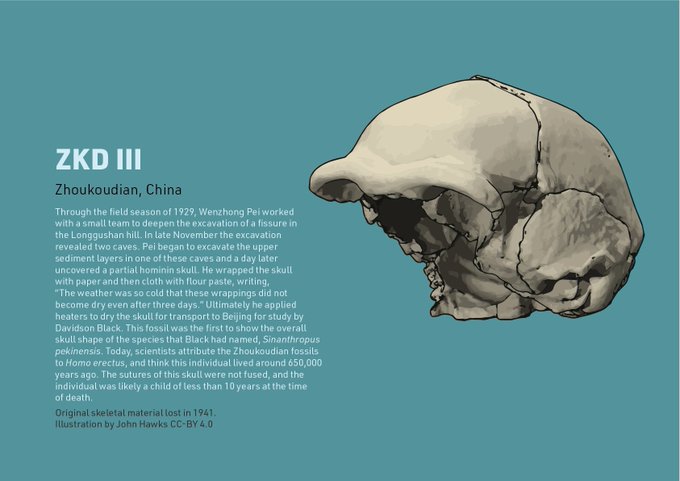AnthropologyのTwitterイラスト検索結果。 418 件中 9ページ目
The Mojokerto #hominin skull is one of the most important clues about brain size development in Homo erectus. At less than 4 years old, its brain was already larger than many adults known for the species. #paleoanthropology
New @StatedClearly upload: DNA Evidence that Humans and Chimps Share A Common Ancestor.
#evolutionsoup #evolution #paleontology #paleoanthropology #science
👉🏻👉🏽https://t.co/g73aDPhVDi
The discovery of the MLD 18 #hominin mandible in 1953 followed the sorting and movement of more than 5000 tons of miners' dump material. The fossil comes from one of the older adult individuals known for Australopithecus africanus. #paleoanthropology
The three bones of the Swanscombe #hominin skull were found across 20 years within a gravel layer in the course of the ancient Thames River. The skull belonged to an early relative of Neandertals. #paleoanthropology #sciart
The La Quina 18 individual is one of the most complete skulls of a Neandertal child. Impressed with the Mousterian stone tools there, Léon Henri-Martin bought the site and excavated there for thirty years. #paleoanthropology
In 2002, a travertine quarry near Kocabaş, Turkey, sliced through a Homo erectus skull. Only one 35-mm segment was identified. The rest of this 1.4-million-year-old #hominin skull might possibly be tiled into someone's floor. #paleoanthropology
Some of the most significant #hominin fossil collections are those that represent at least some of the anatomy of several individuals. Most scientists interpret the fossils from Ngandong, Indonesia, as Homo erectus individuals just before 100,000 years ago. #paleoanthropology
Apidima 1 may be the earliest European #hominin fossil aligned with African ancestors of modern people, more than 210,000 years old. But some specialists suggest it was an ancestor of Neandertals. Of course, it may be both. #paleoanthropology
The Dmanisi site has some of the most informative postcranial remains of Homo erectus, telling us about the body size and locomotion of this #hominin species. D4167 comes from an individual of around 155 cm in stature. #paleoanthropology
New nature writing, history, anthropology or popular science? Brilliant non-fiction books arriving on our virtual shelves... https://t.co/NQBE96uEi9
The late André Keyser was faced with the problem of extricating the DNH 7 #hominin skull from an ant colony and tangle of plant roots. The pieces today comprise the most complete known skull of Paranthropus robustus #paleoanthropology
The travertine site at Bilzingsleben, Germany, has fossils from straight-tusked elephants, woolly rhinos, and macaques dating to an interglacial probably 400,000 years ago. The #hominin population left tools and remains of at least two individuals. #paleoanthropology
The MH2 #hominin mandible is still being built, fragment by fragment, as pieces are recovered from Malapa and prepared in the lab. The skull of this adult Australopithecus sediba individual may be found within the breccia as well. #paleoanthropology
KNM-ER 3733 helped establish that #hominin evolution was a branching tree and not a straight line. Alan Walker famously cracked the skull into three pieces with a chisel to remove the hard rock from inside, enabling reconstruction of the face. #paleoanthropology #FossilFriday
As the smallest mandible in the highly variable Sterkfontein Member 4 #hominin sample, Stw 404 has been a key fossil in understanding whether all these fossils represent Australopithecus africanus, or some of them may represent a second, larger species. #paleoanthropology
The Canadian anatomist Davidson Black died at his desk in 1934 with the skull of Sinanthropus from Locus E beside him. This #hominin skull was unearthed by Wenzhong Pei in 1929 deep within a fissure cave in Longgushan, or "Dragon Bone Hill" #paleoanthropology
Some skulls of Homo erectus have exceptionally thick cranial bones. This #hominin individual from Sangiran, Indonesia, has a thickened bar of bone on the back, known as the nuchal torus, defining the area above the trapezius muscle. #paleoanthropology
The AL 400-1 #hominin jaw was chewed by a carnivore before it was fossilized 3.3 million years ago. This individual is attributed to Australopithecus afarensis. #paleoanthropology
BOU-VP-16/1 is one of three #hominin skulls from near Herto, Ethiopia, that bear cutmarks or other signs of mortuary practices. The discoveries came near some of the latest Acheulean handaxe-dominated assemblages in Africa, around 155,000 years old. #paleoanthropology
Estimates of the age of fossil #hominin children have come a long way in 50 years. Still, we have much to learn about the variation in enamel growth rates in some species, including Australopithecus afarensis. The LH 2 child died at around 3.25 years of age. #paleoanthropology

























